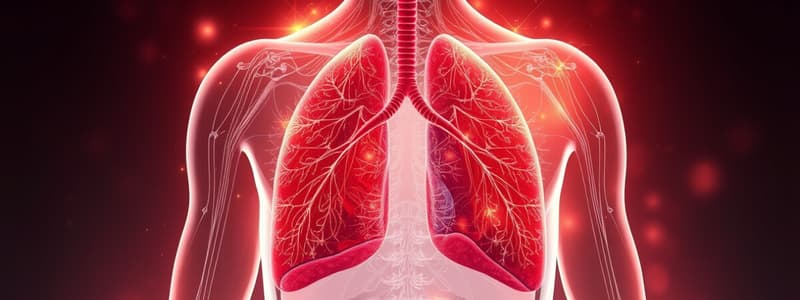Podcast
Questions and Answers
Which part of the respiratory system primarily facilitates gas exchange?
Which part of the respiratory system primarily facilitates gas exchange?
- Diaphragm
- Trachea
- Alveoli (correct)
- Bronchi
What is one of the protective functions of the respiratory system?
What is one of the protective functions of the respiratory system?
- It blocks harmful particles from entering. (correct)
- It heats the air solely for comfort.
- It enhances the taste of food.
- It filters out excess nutrients from the air.
How does the respiratory system prepare the air for the body's needs?
How does the respiratory system prepare the air for the body's needs?
- By compressing it into smaller particles.
- By warming and moisturizing it. (correct)
- By eliminating odors before entering.
- By increasing its speed.
What role do vocal cords play in the respiratory system?
What role do vocal cords play in the respiratory system?
Which of the following best describes the primary function of the respiratory system?
Which of the following best describes the primary function of the respiratory system?
What is the primary role of the respiratory system?
What is the primary role of the respiratory system?
Which part of the respiratory system is primarily responsible for gas exchange?
Which part of the respiratory system is primarily responsible for gas exchange?
What happens to blood pH when there is an excess of carbon dioxide?
What happens to blood pH when there is an excess of carbon dioxide?
What is the function of the diaphragm in the respiratory process?
What is the function of the diaphragm in the respiratory process?
Which of the following is NOT a component of the upper respiratory tract?
Which of the following is NOT a component of the upper respiratory tract?
What condition is characterized by a reduction in airflow due to inflammation of the airways?
What condition is characterized by a reduction in airflow due to inflammation of the airways?
Which test is typically used to determine blood oxygen levels in the respiratory system?
Which test is typically used to determine blood oxygen levels in the respiratory system?
What is the most common symptom associated with respiratory infections?
What is the most common symptom associated with respiratory infections?
Which structure serves as the main site for the regulation of air humidity and temperature?
Which structure serves as the main site for the regulation of air humidity and temperature?
What condition is associated with lung tissue scarring, affecting respiratory function?
What condition is associated with lung tissue scarring, affecting respiratory function?
Flashcards are hidden until you start studying
Study Notes
Overview of the Respiratory System
- Composed of lungs, airways (trachea, bronchi, bronchioles), diaphragm, voice box, throat, nose, and mouth.
- Primary function: intake of oxygen and elimination of carbon dioxide.
- Protects against harmful particles and pathogens, and aids in smell and speech.
Structure of the Respiratory Tract
- Upper Respiratory Tract: Includes nose, mouth, nasal cavity, sinuses, pharynx, and larynx.
- Lower Respiratory Tract: Comprises trachea, bronchi, and lungs, further divided into bronchioles and alveoli.
Main Functions
- Gas Exchange: Oxygen is absorbed into the blood, carbon dioxide is expelled.
- Air Conditioning: Warms and moistens inhaled air to body temperature and humidity levels.
- Protection: Blocks harmful particles through mucus and cilia, which trap and expel irritants.
- Vocalization: Vocal cords vibrate as air passes through, enabling sound production.
- Sense of Smell: Inhaled air triggers olfactory nerve signals to the brain.
Anatomy and Components
- Nasal and Oral Cavities: Initial air entry points that enhance humidity and temperature.
- Sinuses: Air-filled spaces that help regulate air temperature and humidity.
- Diaphragm: Essential muscle that aids in breathing by changing chest cavity volume.
Respiratory Process
- Inhalation: Diaphragm contracts, expanding chest cavity, allowing air to flow into the lungs.
- Alveoli: Tiny air sacs where oxygen enters the blood, and carbon dioxide is removed.
- Exhalation: Diaphragm relaxes, reducing chest cavity volume, pushing air out.
Common Conditions and Disorders
- Allergic Rhinitis: Allergic responses affecting nasal passages.
- Chronic Conditions: Asthma and COPD, resulting in airway obstruction.
- Infections: Includes influenza and pneumonia, impacting lung function.
- Inflammatory Disorders: Bronchitis and sinusitis due to infections.
- Blockages: Caused by foreign objects or growths impeding airflow.
- Acid-Base Imbalance: Respiratory alkalosis or acidosis from abnormal carbon dioxide levels.
Signs and Symptoms
- Shortness of breath (dyspnea) and runny or stuffy nose.
- Cyanosis: bluish skin, lips, or nails indicating oxygen deficiency.
Diagnostic Tests
- Pulse Oximetry: Measures blood oxygen levels using a finger device.
- Pulmonary Function Tests: Assess lung capacity and function.
- Chest X-rays: Visualize lung conditions.
- Arterial Blood Gas Tests: Determine the gas exchange efficiency.
Treatment Approaches
- Inhaled Medications: Corticosteroids or bronchodilators for asthma and COPD.
- Antimicrobial Treatments: Antivirals, antibiotics, or antifungals for infections.
- Antihistamines: Counteract allergic reactions.
- Surgery: For tumor removal or other obstructions.
Maintaining Respiratory Health
- Avoid smoking or vaping due to associated diseases.
- Minimize exposure to air pollutants; use masks if necessary.
- Stay hydrated to keep lung mucus thin.
- Regular exercise strengthens respiratory muscles.
- Practice hygiene and get vaccinated to prevent infections.
When to Seek Medical Attention
- Persistent or worsening cough, breathing difficulties, or other respiratory symptoms warrant a healthcare visit.
- Regular checkups are crucial for early diagnosis and intervention.
Studying That Suits You
Use AI to generate personalized quizzes and flashcards to suit your learning preferences.




